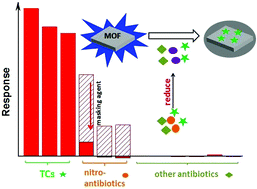Metal–organic framework-based fluorescent sensing of tetracycline-type antibiotics applicable to environmental and food analysis†
Abstract
Antibiotics have been noted as an important class of emerging contaminants in the environment. Metal–organic frameworks (MOFs), which have been intensely investigated as a novel kind of sensing material, have been tentatively applied to the detection of antibiotics in recent years. In this work, a nanoscale MOF (In-sbdc) with a strong (quantum yield = 13%) and stable emission in water was synthesized. With its effective spectral overlap with tetracyclines, adsorption preconcentration and the usage of a masking agent, In-sbdc gave sensitive responses to a series of tetracycline antibiotics (tetracycline, chlorotetracycline and oxytetracycline) with detection limits of 0.28–0.30 μM, but another eight tested kinds of antibiotics did not cause a remarkable change in its emission (<10% of the response caused by an equal amount of tetracyclines). This MOF-based sensing system was successfully applied to tetracyclines detection in a series of actual water and food samples.



 Please wait while we load your content...
Please wait while we load your content...